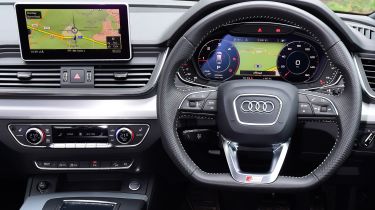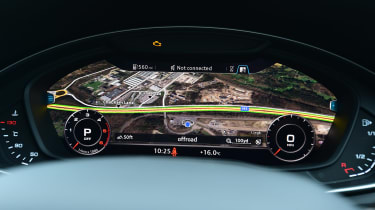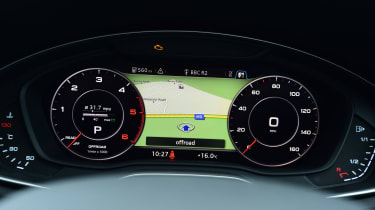What is Audi's Virtual Cockpit?
We give you the lowdown on Audi's hi-tech dashboard display screen, the Virtual Cockpit
If you have ever driven or ridden in the front passenger seat of a current Audi car, chances are you may have seen a Virtual Cockpit display. The Virtual Cockpit is not some sort of phantom car interior that only exists in a VR headset, instead it's Audi's name for the digital dashboard display that it now fits to many of its models in place of conventional analogue dials.
Virtual Cockpit first appeared on the 2014 Audi TT Mk3, although a version of it was also used on the Lamborghini Huracan that was launched in the same year. Today, the system has trickled down through the rest of the range, and a majority of Audi cars now come with the Virtual Cockpit tech as standard.
On versions that aren’t fitted with it as standard (such as the entry- and mid-range trim levels on the Audi A6 executive saloon), Virtual Cockpit can be specified as an optional extra – usually as part of a Technology Pack that costs around £1,500. The only exceptions are the most basic Technik versions of the Audi A1 and Audi Q2, which can’t be specified with the Virtual Cockpit system at all.
Virtual Cockpit still feels cutting edge, but Audi and the VW Group isn’t the only carmaker pursuing the digital dashboard route. BMW drivers have the Digital Live system while Mercedes has MBUX, and digital displays are becoming increasingly common everywhere, as you might expect.
But how does Virtual Cockpit work? Essentially the Virtual Cockpit is a self-contained piece of electronics with a computer processor sourced from tech giant Nvidia. It features a digital display that can be programmed to show different information according to user preferences. The display is 12.3 inches across and also designed to fit inside the conventional instrument binnacle, so it's an easy extra to add if you're upgrading a dashboard display.
In most cases, the Virtual Cockpit screen will be 12.3-inches across, and displays all of the information that would normally be shown using conventional dials and instruments. However, this sometimes varies depending on the car and the chosen spec. For example, while the 12.3-inch screen comes as standard on the range-topping Edition 1 and Vorsprung versions of the Audi A3, the other trims are only available with a slightly smaller 10.25-inch setup. This size of Virtual Cockpit screen is also flanked by separate digital readouts, for features like the fuel gauges and warning lights.
The Audi Virtual Cockpit has a number of settings that can be adjusted by the driver, and varies depending on the car you're in. Changes are made via the multifunction steering wheel that is standard with models equipped with the Virtual Cockpit. You can program the display to show map information, including Google 3D mapping if you've specced that option, the advanced trip computer, phone book or audio information. Another button on the wheel can reduce or enlarge the dials to make more room for the additional information, too.
On some of Audi’s sportier models, such as the RS 6 Avant and RS Q8, there is also an ‘RS Mode’ for the Virtual Cockpit. In this setting, the display is simplified so it mainly shows performance info, such as the car’s current speed and the gear it’s in. This Virtual Cockpit setting’s retro rev gauge graphic, which mimics the one on the Audi Quattro from the 1980s, is also a nice touch.
Reliability was a bit of an issue when the Virtual Cockpit first appeared in Audi's cars, with the display not working properly, maps freezing and strange read-outs on the screen when in operation. But thanks to the software that's used, engineers have been able to iron out any bugs, so the current system is a lot more reliable. If you're looking at a used car with the Virtual Cockpit, make sure it has the latest software updates to ensure the system works properly.
Older digital displays suffered from glare in sunlight, but with the current trend for heavily cowled dials, engineers have managed to make the Virtual Cockpit legible in all light conditions.
Audi debuted the Virtual Cockpit, but as mentioned, it's also used by Lamborghini, while Volkswagen has also introduced its own version, called the Active Info Display. And the VW Group isn't the only company to embrace digital display technology. Mercedes has its own high-resolution screens on cars like the E-Class and S-Class, while Renault, Volvo and PSA Peugeot Citroen use these displays, too.
Do you have Audi's Virtual Cockpit in your car? Tell us about your experiences below...
Find a car with the experts












